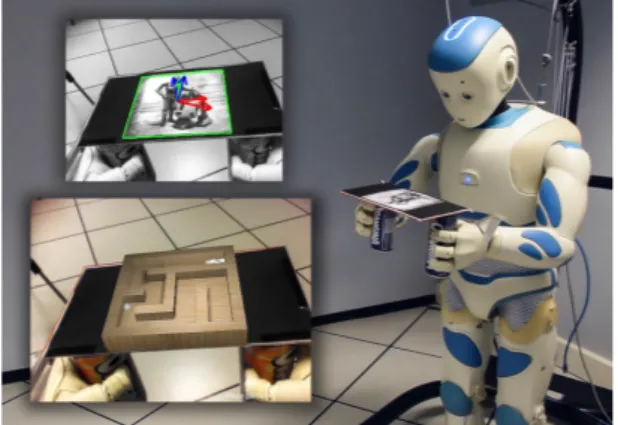HAL Id: hal-01358124
https://hal.inria.fr/hal-01358124
Submitted on 31 Aug 2016
HAL is a multi-disciplinary open access
archive for the deposit and dissemination of
sci-entific research documents, whether they are
pub-lished or not. The documents may come from
teaching and research institutions in France or
abroad, or from public or private research centers.
L’archive ouverte pluridisciplinaire HAL, est
destinée au dépôt et à la diffusion de documents
scientifiques de niveau recherche, publiés ou non,
émanant des établissements d’enseignement et de
recherche français ou étrangers, des laboratoires
publics ou privés.
Dual arm manipulation and whole body control with the
humanoid robot Romeo by visual servoing
Giovanni Claudio, Don Joven Agravante, Fabien Spindler, François Chaumette
To cite this version:
Giovanni Claudio, Don Joven Agravante, Fabien Spindler, François Chaumette. Dual arm
manipula-tion and whole body control with the humanoid robot Romeo by visual servoing. 2016. �hal-01358124�
Dual arm manipulation and whole body control with the humanoid robot
Romeo by visual servoing
Giovanni Claudio, Don Joven Agravante, Fabien Spindler and Fran¸cois Chaumette
Lagadic group at Inria Rennes-Bretagne Atlantique & Irisa
Campus Universitaire de Beaulieu, 35042 Rennes Cedex
giovanni.claudio@inria.fr, don-joven.agravante@inria.fr, fabien.spindler@inria.fr, francois.chaumette@irisa.fr
Abstract
The purpose of this presentation is to show two visual-servoing applications on the humanoid robot Romeo: dual arm manipulation and preliminary results on the implementation of a whole body control framework.
Figure 1: Romeo solves a ball-in-maze game in augmented reality using two hands. Only vision is used to control both arms.
In the control scheme for the dual arm manipulation, we consider the case of two arms creating a closed kinematic chain and holding a rigid body object with fixed grasp handles. For this kind of task, common solutions are hybrid force/position control and impedance control. However, if the arms are not equipped with any force sen-sors, as in our case, an alternative solution is needed. The aim here is to control both arms using a Pose-Based Visual Servoing and a master/slave approach, in order to apply any translation and rota-tion to the grabbed object, just by knowing its pose with respect to the camera. To validate our approach, we developed an augmented reality demonstration. The two arms, 14 joints in total, are holding a tray from two handles as in Figure 1. A known picture is placed on the tray, it is detected automatically and then tracked using the template tracker in ViSP [1]. Furthermore, this algorithm computes the 6D pose of the picture with respect to the camera. A virtual maze is added in augmented reality on the top of the tray and its pose is directly linked with the pose of the picture. The aim of the game is to roll the virtual ball from its actual position to the end of the maze1. The main software used to develop this framework are the Aldebaran SDK C++, ViSP, ViSPNaoqi, Panda3D2, Metapod3
and OpenCV. The source code of this demonstration is available online on GitHub4.
The whole body control framework consists in adapting on Romeo, the multi-objective quadratic program controller presented in [2], which was originally implemented on the HRP-2 robot. Our preliminary results show that visual servoing tasks can be achieved along with common tasks, such as maintaining a posture, balancing and avoiding joint limits. For this purpose, an Image-Based Visual Servoing is used to track the hand with the gaze. Simultaneously, a Position-Based Visual Servoing is used to move the hand from its current position to a desired one, in order to accomplish manipulation tasks, such as grasping. This approach leads to a larger workspace and enables the performance of more complex motions than our previous solution [3].
Acknowledgement
This work was partly funded by the Oseo Romeo 2 Project.
References
[1] E. Marchand, F. Spindler, F. Chaumette. “ViSP for visual servoing: a generic software platform with a wide class of robot control skills”, IEEE Robotics and Automation Magazine, Special issue on “Software Packages for Vision-Based Control of Motion”, 12(4):40-52, December 2005, http://team.inria.fr/lagadic/visp
[2] J. Vaillant, A. Kheddar, H. Audren, F. Keith, S. Brossette, A. Escande, K. Bouyarmane, K. Kaneko, M. Morisawa, P. Gergondet, E. Yoshida, S. Kajita, & F. Kanehiro. “Multi-contact vertical ladder climbing with an HRP-2 humanoid”, Autonomous Robots, 2016, 40, 561-580
[3] G. Claudio, F. Spindler, F. Chaumette. “Grasping by Romeo with visual servoing”, Journ´ees Nationales de la Robotique Humano¨ıde (JNRH), Jun 2015, Nantes, France, <hal-01159882>
1Video dual arm manipulation: https://youtu.be/-wIzJ2Ckifg 2https://www.panda3d.org/
3
https://github.com/laas/metapod
4https://github.com/lagadic/
